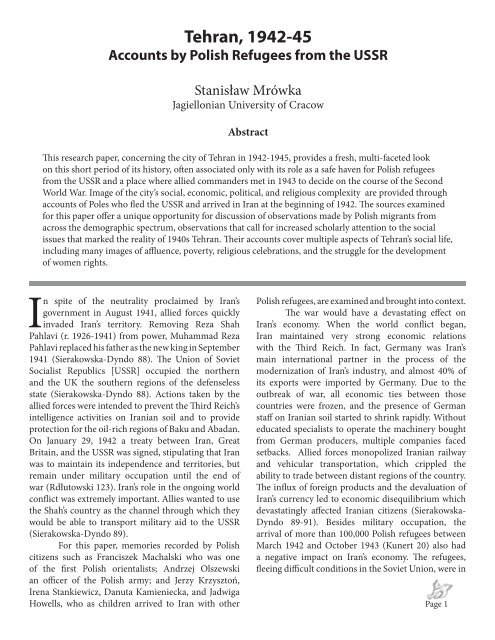You also want an ePaper? Increase the reach of your titles
YUMPU automatically turns print PDFs into web optimized ePapers that Google loves.
Tehran, 1942-45<br />
Accounts by Polish Refugees from the USSR<br />
Stanisław Mrówka<br />
Jagiellonian University of Cracow<br />
Abstract<br />
This research paper, concerning the city of Tehran in 1942-1945, provides a fresh, multi-faceted look<br />
on this short period of its history, often associated only with its role as a safe haven for Polish refugees<br />
from the USSR and a place where allied commanders met in 1943 to decide on the course of the Second<br />
World War. Image of the city’s social, economic, political, and religious complexity are provided through<br />
accounts of Poles who fled the USSR and arrived in Iran at the beginning of 1942. The sources examined<br />
for this paper offer a unique opportunity for discussion of observations made by Polish migrants from<br />
across the demographic spectrum, observations that call for increased scholarly attention to the social<br />
issues that marked the reality of 1940s Tehran. Their accounts cover multiple aspects of Tehran’s social life,<br />
including many images of affluence, poverty, religious celebrations, and the struggle for the development<br />
of women rights.<br />
In spite of the neutrality proclaimed by Iran’s<br />
government in August 1941, allied forces quickly<br />
invaded Iran’s territory. Removing Reza Shah<br />
Pahlavi (r. 1926-1941) from power, Muhammad Reza<br />
Pahlavi replaced his father as the new king in September<br />
1941 (Sierakowska-Dyndo 88). The Union of Soviet<br />
Socialist Republics [USSR] occupied the northern<br />
and the UK the southern regions of the defenseless<br />
state (Sierakowska-Dyndo 88). Actions taken by the<br />
allied forces were intended to prevent the Third Reich’s<br />
intelligence activities on Iranian soil and to provide<br />
protection for the oil-rich regions of Baku and Abadan.<br />
On January 29, 1942 a treaty between Iran, Great<br />
Britain, and the USSR was signed, stipulating that Iran<br />
was to maintain its independence and territories, but<br />
remain under military occupation until the end of<br />
war (Rdłutowski 123). Iran’s role in the ongoing world<br />
conflict was extremely important. Allies wanted to use<br />
the Shah’s country as the channel through which they<br />
would be able to transport military aid to the USSR<br />
(Sierakowska-Dyndo 89).<br />
For this paper, memories recorded by Polish<br />
citizens such as Franciszek Machalski who was one<br />
of the first Polish orientalists; Andrzej Olszewski<br />
an officer of the Polish army; and Jerzy Krzysztoń,<br />
Irena Stankiewicz, Danuta Kamieniecka, and Jadwiga<br />
Howells, who as children arrived to Iran with other<br />
Polish refugees, are examined and brought into context.<br />
The war would have a devastating effect on<br />
Iran’s economy. When the world conflict began,<br />
Iran maintained very strong economic relations<br />
with the Third Reich. In fact, Germany was Iran’s<br />
main international partner in the process of the<br />
modernization of Iran’s industry, and almost 40% of<br />
its exports were imported by Germany. Due to the<br />
outbreak of war, all economic ties between those<br />
countries were frozen, and the presence of German<br />
staff on Iranian soil started to shrink rapidly. Without<br />
educated specialists to operate the machinery bought<br />
from German producers, multiple companies faced<br />
setbacks. Allied forces monopolized Iranian railway<br />
and vehicular transportation, which crippled the<br />
ability to trade between distant regions of the country.<br />
The influx of foreign products and the devaluation of<br />
Iran’s currency led to economic disequilibrium which<br />
devastatingly affected Iranian citizens (Sierakowska-<br />
Dyndo 89-91). Besides military occupation, the<br />
arrival of more than 100,000 Polish refugees between<br />
March 1942 and October 1943 (Kunert 20) also had<br />
a negative impact on Iran’s economy. The refugees,<br />
fleeing difficult conditions in the Soviet Union, were in<br />
Page 1


